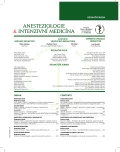Body temperature in the anaesthetised child
Authors:
V. Mixa; V. Kaplanová
Authors‘ workplace:
Klinika anesteziologie, resuscitace a intenzivní medicíny 2. LF UK a FN Motol, Praha
Published in:
Anest. intenziv. Med., 27, 2016, č. 5, s. 320-326
Category:
Overview
Perioperative hypothermia is a serious complication of anaesthesia and is associated with many adverse consequences, including circulatory instability, respiratory depression and prolonged effects of the anaesthetics. The greatest caution should be applied to newborns and young children who are more prone to perioperative decrease in body temperature because of their relatively large body surface area and a thin layer of subcutaneous fat. The main mechanisms of heat loss in the operating theatre are conduction and radiation, convection and evaporation. Optimum thermal homeostasis during anaesthesia in children can be achieved through combining various procedures, e.g. using warming-up air mattresses, waterproof drapes, warming of infusion solutions, or preventing airflow around the patient. Perioperative body temperature can be measured using skin, oesophageal, rectal and tympanic thermometers, or the SpontOn device, which creates and uses an isothermal channel into the body core.
Reliable body temperature measurement also helps to prevent iatrogenic hyperthermia.
KEYWORDS:
paediatric anaesthesia – hypothermia – thermal homeostasis – thermoregulation – body temperature measurement
Sources
1. Sessler, D. I. Perioperative thermoregulation and heat balance. Lancet, 2016, Epub. ahead of print.
2. Hannenberg, A. A., Sessler, D. I. Improving Perioperative Temperature Management. Anesth. Analg., 2008, 107, 5, p. 1454–1457.
3. Duryea, E. L., Nelson, D. B., Wyckoff, M. H., Grant, E. N., Tao, W. et al. The impact of ambient operating room on neonatal and maternal hypothermia and associated morbidities: a randomized controlled trial. Am. J. Obstet. Gynecol., 2016, 214, 4, p. 505.e1-7.
4. Obare Pyszková, L., Nevtípilová, M., Žáčková, D., Fritscherová, Š., Zapletalová, J., Hrabálek, L., Adamus, M. Výskyt hypotermie v perioperačním období – unicentrická observační studie. Anest. Intenziv. Med., 2014, 25, 4, p. 267–273.
5. Shorrab, A. A., El-Sawy, M. E., Othman, M. M., Hammouda, G. E. Prevention of hypothermia in children under combinad epidural and general anesthesia: a comparison between upper - and lower - body warming. Paediatr. Anaesth., 2007, 17, 1, p. 38–43.
6. Kim, P., Taghon, T., Fetzer, M., Tobias, J. D. Perioperative hypothermia in the pediatric population: a quality improvement project. Am. J. Med. Qual., 2013, 28, 5, p. 100–106.
7. Witt, L., Dennhardt, N., Eich, C., Mader, T., Fischer, T., Bräuer, A., Sümpelmann, R. Prevention of intraoperative hypothermia in neonates and infants: results of a prospective multicenter observational study with a new forced-air warming system with increased warm air flow. Paediatr. Anaesth., 2013, 23, 6, p. 469–474.
8. Torossian, A. Thermal management during anaesthesia and thermoregulation standards for the prevention of inadvertent perioperative hypothermia. Clinical Anestesilogy, 2008, 22, 4, p. 659–668.
9. Shen, J., Wang, Q., Zhang, Y., Wang, X., Shi, P. Combination of warming blanket and prewarmed intravenous infuzion is effective for rewarming in infants with postoperative hypothermia in China. Paediatr. Anaesth., 2015, 25, 11, p. 1139–1143.
10. Torossian, A., Bräuer, A., Höcker, J., Bein, B., Wulf, H., Horn, E. P. Preventing inadvertent perioperative hypothermia. Dtsch. Arztebl. Int., 2015, 112, 10, p. 166–172.
11. Sahin, S. H., Duran, R., Sut, N., Colak, A., Acunac, B., Aksu, B. Comparison of temporal artery, nasopharyngeal, and axillary temperature measurement during anesthesia in children. J. Clin. Anesth., 2012, 24, 8, p. 647–651.
12. Drake-Brockman, T. F., Hegarty, M., Chambers, N. A., von Ungern-Sternberg, B. S. Monitoring temperature in children undergoing aneasthesia: a comparison of methods. Anaesth. Intensive Care, 2014, 42, 3, p. 315–320.
13. Iden, T., Horn, E. P., Bein, B., Böhm, R., Beese, J., Höcker, J. Intraoperative temperature monitoring with zero heat flux technology (3M SpotOn sensor) in comparison with sublingual and nasopharyngeal temperature: An observational study. Eur. J. Anaesthesiol., 2015, 32, 10, p. 747.
Labels
Anaesthesiology, Resuscitation and Inten Intensive Care MedicineArticle was published in
Anaesthesiology and Intensive Care Medicine

2016 Issue 5
Most read in this issue
- Hypotension following induction to general anaesthesia: prevalence, significance, risk factors and preventive management options
- The 2016 definition of sepsis (Sepsis-3)
- Selected aspects of anaesthesia for non-obstetric surgical procedures in the pregnant patient
- Body temperature in the anaesthetised child
